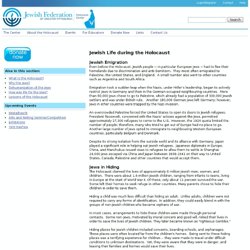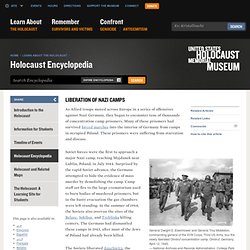

When did the Holocaust begin? The question is both pertinent and impossible to answer easily, and it demonstrates why the study of the Holocaust remains important. If what is meant by the "start" of the Holocaust is the decision to exterminate the Jews , it can be argued that this was the inevitable conclusion of the logic of bigotry. That is, if the ills of society are blamed on the existence of a certain group of people – as the Nazis did with Jews – sooner or later someone will suggest that this inherently detrimental group should be eliminated.
This almost happened in the United States with its shameful treatment of Native Americans, although they never crossed the line between bigotry and a decision to exterminate the entire group. Jewish Life during the Holocaust. Even before the Holocaust, Jewish people -- in particular European Jews -- had to flee their homelands due to discrimination and anti-Semitism.

They most often emigrated to Palestine, the United States, and England. A small number also went to other countries such as Argentina and South Africa. Emigration took a sudden leap when the Nazis, under Hitler’s leadership, began to actively restrict Jews in Germany and then in the German-occupied neighbouring countries. More than 60,000 Jews chose to go to Palestine, which already had a population of 300,000 Jewish settlers and was under British rule. Another 180,000 German Jews left Germany; however, Jews in other countries were trapped by the Nazi invasion. An overcrowded Palestine forced the United States to open its doors to Jewish refugees. Despite its strong isolation from the outside world and its alliance with Germany, Japan played a significant role in helping out Jewish refugees. The Holocaust: An Introductory History. The Holocaust (also called Ha-Shoah in Hebrew) refers to the period from January 30, 1933 - when Adolf Hitler became chancellor of Germany - to May 8, 1945, when the war in Europe officially ended.

During this time, Jews in Europe were subjected to progressively harsher persecution that ultimately led to the murder of 6,000,000 Jews (1.5 million of these being children) and the destruction of 5,000 Jewish communities. These deaths represented two-thirds of European Jewry and one-third of all world Jewry. The Jews who died were not casualties of the fighting that ravaged Europe during World War II. Rather, they were the victims of Germany's deliberate and systematic attempt to annihilate the entire Jewish population of Europe, a plan Hitler called the “Final Solution” (Endlosung). Background Propaganda: “The Jews Are Our Misfortune” Racial policy of Nazi Germany. Eva Justin of the 'Racial Hygiene and Demographic Biology Research Unit' measuring the skull of a Romani woman.
The racial policy of Nazi Germany was a set of policies and laws implemented by Nazi Germany, asserting the superiority of the "Aryan race", and based on a specific racist doctrine which claimed scientific legitimacy. It was combined with a eugenics programme that aimed for racial hygiene by using compulsory sterilizations and extermination of the Untermenschen (or "sub-humans"), and which eventually culminated in the Holocaust. These policies targeted peoples, in particular Jews, as well as Gypsies, homosexuals and handicapped people, ethnic Poles,[1] Russians[2] who were labeled as "inferior" in a racial hierarchy that placed the Herrenvolk (or "master race") of the Volksgemeinschaft (or "national community") at the top, and ranked Russians, Romani, Serbs, Poles, persons of color and Jews at the bottom.[2][3][4][5] Racial policies regarding the Jews, 1933-1940[edit]
Holocaust Museum. Suitcase of a Holocaust Survivor. Jewish Population. Holocaust Entrance. Lodz Ghetto. Description of Lodz Ghetto. Life in Lodz Ghetto. Life in Lodz Ghetto. Lodz Ghetto. Lodz Ghetto. Jesse Owens ( Germany Olympics) Life in the Concentration Camp. Girl in a Concentration Camp. Living Standards. Liberation of Nazi Camps. As Allied troops moved across Europe in a series of offensives against Nazi Germany, they began to encounter tens of thousands of concentration camp prisoners.

Many of these prisoners had survived forced marches into the interior of Germany from camps in occupied Poland. These prisoners were suffering from starvation and disease. Soviet forces were the first to approach a major Nazi camp, reaching Majdanek near Lublin, Poland, in July 1944. Clothing for a Concetratoin Camper. Prison Identification. Prison Identification. People in a concentration camp. The Dead from the Concentration Camp. The dead. The dead. The dead. Jewish Synagogue (ceiling) Jewish holy book and etc. Jewish book. Childs book. Jewish Holy Book. Burning of books (Germany) Burning of books. Burning books part 2. Holocaust photo. Holocaust Photo. Holocaust Photo.